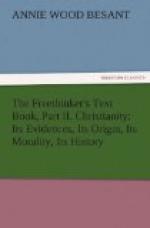and the greatest care has been taken not to omit any.
It will be worth while to note the differences between
this and our Gospels, and also the allusions to other
Gospels which it contains. Christ is clearly
subsequent in time to the Father, being brought forth
from him; he conceives himself, he being here identified
with the Holy Ghost; it is the virgin who descends
from David, a fact of which there is no hint given
in our Gospels; the reason of the name Jesus is told
to the Virgin instead of to Joseph; we hear nothing
of the shepherds and the glory of the Lord round the
chanting angels; Jesus is uncomely, and works making
ploughs and yokes, of which, we hear nothing in the
Gospels; the fire at the baptism is not mentioned
in the Gospels, and the voice from heaven speaks in
words not found in them; he is called a magician,
of which accusation we know nothing from the four;
the colt of the ass is tied to a vine, a circumstance
omitted in the canonical writings; it is no where
said in the New Testament that the bread at the Lord’s
supper is given in remembrance of the incarnation,
but, on the contrary, it is in remembrance of the
death of Christ; the crucifixion is not stated
to have taken place during the Passover, but on the
contrary the Fourth Gospel places it before, the others
after, the Passover; we hear nothing of Christ set
on the judgment seat in the Gospels: the vesture
is not divided according to John, who draws a distinction
between the vesture and the raiment
which is not recognised by Justin; the taunts of the
crowd are different; the denial of Christ by all the
Apostles is uncanonical, as is also their forsaking
him after the crucifixion; we do not hear of
the “day of the Sun” in our Gospels, nor
of the rulers of heaven and their reception of Christ.
In fact, there are more points of divergence than
of coincidence between the details of the story of
Jesus given by Justin and that given in the Four Gospels,
and yet Paley says that: “all the references
in Justin are made without mentioning the author; which
proves that these books were perfectly notorious, and
that there were no other accounts of Christ then extant,
or, at least, no others so received and credited,
as to make it necessary to distinguish these from
the rest” ("Evidences,” p. 123). And
Paley has actually the hardihood to state that what
“seems extremely to be observed is, that in all
Justin’s works, from which might be extracted
almost a complete life of Christ, there are but two
instances in which he refers to anything as said or
done by Christ, which is not related concerning him
in our present Gospels; which shows that these Gospels,
and these, we may say, alone, were the authorities
from which the Christians of that day drew the information
upon which they depended” (Ibid pp. 122, 123).
Paley, probably, never intended that a life of Christ
should “be extracted” from “all
Justin’s works.” It is done above,
and the reader may judge for himself of Paley’s




